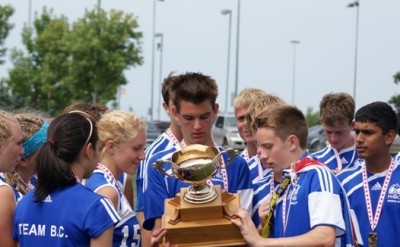
Males Age 12-16; Females Age 11-15
Training to Train stage begins when the child’s major growth spurt begins (onset of Peak Height Velocity [PHV]). On average, PHV occurs at about age 12 for girls and 14 for boys and lasts between 2-5 years. The major focus of this stage is on the consolidation and implementation of the basic skills of field hockey in a competitive arena.
Competition should involve 1-2 matches per week during a season. A season runs over multiple months with proper breaks to allow for rest and recovery. The athletes may play to win and do their best, but they still need to focus more time on skill training and physical development over competition. This approach is critical to the development of top performers and maintaining activity in the long-term. The training to competition ratio shifts to 60:40.
This stage is the most important in terms of developing the physical capacity of the athlete. The second window of trainability for speed occurs at 11-13 for females and 13-16 for males. There are two sensitive periods for strength training for females; the first occurs immediately after PHV and the second begins with the onset of menarche. For males this starts 12-18 months after PHV.
To properly accommodate all the development that should be completed in this stage, an increase in time commitment in the training schedule will be required. Field hockey-specific training should occur three times per week plus other physical activities in and out of school.
Physical
Develop aerobic endurance with the onset of the growth spurt and introduce speed and anaerobic concepts into training towards the end of the stage. This is the second speed window, 11-13 girls and 13-16 boys. Body weight and core stability work should be expanded upon as well as introducing of use of free weights.
Strength training window for females occurs in two stages: the first occurs immediately after PHV and the second begins with the onset of menarche. For males it starts 12-18 months after PHV. Flexibility training is also emphasized. Expanded information is provided to the athlete and injected throughout training in the areas of recovery and regeneration, hydration and nutrition.
Pre- and –post competition physical strategies are developed. Multiple seasons occur with a built in period of rest between seasons to allow for adequate recovery. Single or double periodization takes place.
Technical
Hockey skill introduction: Reverse stick scoop and low hit passing, advanced scoring techniques such as sweeping, chipping, and tipping, slips and high ball receptions, intercepting, stealing, and penalty corner skills. Further development takes place for many passing, receiving, and eliminating skills. Athletes work on the perfection of the FunStix skills.
Goaltenders develop primary skills while being introduced to sliding, left hand, and high clears.
Coaches test the skills through the use of skills in mini and modified games to build confidence. Strengths and weaknesses are identified and addressed while mental skills (focus, confidence) should be built into games and competitions.
Tactical
Basic team and individual tactics are introduced and developed. Elements such as changing pace or direction, off the ball movement, marking, covering, etc. Increase pressure by limiting space in small games. Suggest interchange from zone to man-to-man marking.
Athletes work on consistency of performance under a variety of situations and recognition of game play and decision-making is fostered.
Emphasis on specific positional skills, eg., goalkeepers, defenders, etc.
Mental
Players learn to cope with challenges of competition through education and integration of basic mental skills. Reinforce fair play and advance teamwork.
Mental capacities: PMR (progressive muscular relaxation), basic focus plans and competition strategies, self-talk – aware of thoughts and have method for replacing unproductive self-dialogue, motivation through more advanced goal-setting, use of SMARTER principle – Specific, Measureable, Achievable, Realistic, Time-based, Evaluated, Recorded, confidence by highlighting strengths, and use of imagery.
Start to use pre-competition planning strategies, improved self-awareness, distraction control strategies, competitive attitude, teamwork and communication skills, and reinforce sportsmanship and fair play.
Health
Most participants experience the major growth spurt during this stage. As a result, increased consumption is normal (avg. of 2200 calories for females and 2800 for males). Sufficient balance of nutrient rich foods is important with attention given to calcium, iron, and optimized hydration.
Sleep needs increase with rapid growth
Strength and Flexibility: Introduce free weight technique, but no maximal or near-maximal strength activities to preserve growth plates. Flexibility should be emphasized during the growth spurt.
Injury Prevention: Improved aerobic fitness decreases risk of injury from fatigue and enhances recovery. Introduce injury prevention programs for shoulder and low back because risk of repetitive use injury increases, provide at least 6-8 weeks of preseason conditioning prior to intense sport participation, modify training programs (ie., correct muscle flexibility and strength imbalance, decrease volume and intensity of training/during periods of rapid growth), and ensure that all injuries are fully rehabilitated.

